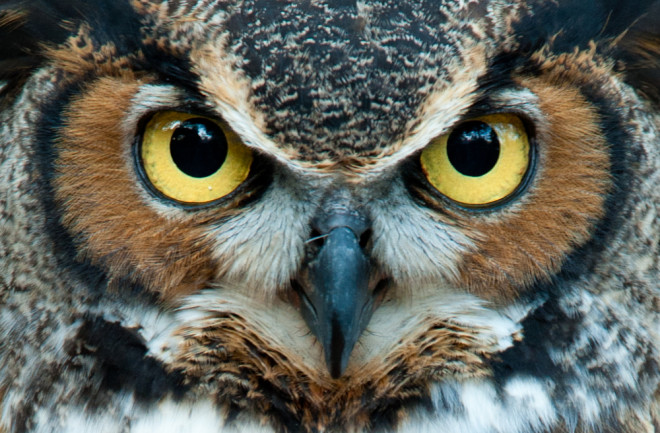Sight is one of the most widespread senses in the animal kingdom. In fact, eyes have independently evolved among life on Earth an estimated 40 times. Where would the world be without its colors and shades?
But, as delightful as the world appears through human eyes, it's but a shadow of the splendors seen by creatures with larger, more sophisticated visual faculties.
Let's take a look at six optically exceptional animals, from wide-eyed owls to colossal giant squids.
1. Owls
Owls are the bird world’s silent killers, flying with feathers designed to cushion the air and minimize noise as these nocturnal predators approach. Their quarry usually consists of small rodents, which themselves have very sensitive vision and hearing. To see their prey before it sees them, owls have some of the most advanced eyes of the avian kingdom, estimated to be nearly 100 times as sensitive to light in the dark as ours.
Read More: 5 Unusually Large Animals You Probably Haven’t Heard Of
And if that wasn’t enough, their eyes are extremely heavy, relatively speaking. Humans have serviceable vision for the purposes of navigating during the day, spotting friend and foe in the distance, and reading online articles; as such, our peepers comprise around 0.003 percent of our total mass as adults. For the owl, it’s closer to 5, or the equivalent to an average human carrying a seven-pound, eyeball-shaped dumbbell in their head.
Beyond that, the birds also have extra rods in their retinas, which detect movement and shadows. An extra membrane, called the tapetum lucidum, reflects any light that the cones missed, bouncing it back through the visual center for increased acuity.
In short, if you ever shine a flashlight at an owl at night, you’d have trouble missing their glowing ocular orbs.
2. Ostriches
Of course, owls are flying birds and must limit their weight lest they become one of the world’s numerous species of flightless birds. For the already flightless ostrich (Struthio camelus), this isn’t a problem, allowing them to grow the largest eyes of any vertebrate land animal.
Used to spot distant and often camouflaged predators in their savannah habitat, an ostrich's eyes are actually larger than the brains they use to process that visual information.
The ostrich’s billiard-ball-sized eyes, five times larger than a human’s, can pick out a dog-sized animal from three kilometers away. The goal of an ostrich is to spot a hunter and bolt before it can catch them. It’s a good thing ostriches can run at over 45 miles per hour, giving them a chance to outrun predators like lions, leopards, hyenas, and cheetahs.
3. Tarsiers
Beyond birds, mammals have also produced their own fair share of visually proficient critters. Enter the tarsier, among the world's smallest primates, which has the largest eyes relative to body size of any mammal.
Each eyeball is about the size of the primate’s brain, allowing it to pick up the nighttime shadows of its jungle habitat, located on the islands of Southeast Asia.
Read More: 5 of the World’s Most Intelligent Animals
In contrast to other night hunters, like owls, who have a handy tapetum layer to reflect extra light through their retina, tarsiers simply evolved very large eyes. And, like owls, they have a disproportionate number of motion-sensitive rods relative to color-sensitive cones in their eyes. This gives tarsiers excellent night vision, just at the expense of their ability to see color well.
Tarsiers use this vision to spot tiny insect and arachnid prey mulling about in the evening. However, acute vision has its price: Tarsier’s skulls are unusually delicate to compensate for their enormous eye sockets — in fact, they're so fragile that a head-on collision with a cage can kill a captive animal. Tarsiers in captivity have even been observed inflicting these lethal injuries on themselves.
4. Squids
However, for the true champions of eye size, one must dip far below the water. That's because the world-record holder for largest animal eye is none other than the colossal squid. Its ocular bulbs are indeed as big as its name suggests, measuring up to 11 inches across.
Colossal squids, able to grow to a maximum recorded length of 33 feet (tentacles included), use their eyes to detect faint traces of bioluminescence in the ocean’s midnight zone, thousands of feet beneath the sunlit surface. Scientists suggest that they use glowing patches behind their eyes, called photophores, as a type of biological headlight, allowing the squids to track any movement they see in the murky depths.
While colossal squid have the largest eyes in the animal kingdom, they are outclassed in another metric: eye-to-body-mass ratio. The tarsier may win this category for the mammals, but the world champion, overall, is the vampire squid. Much smaller than the colossal squid, at only a foot in length at most, its eyes are around an inch wide, useful for parsing out light in its deepwater habitat.
Like their colossal cousins, vampire squid uses photophores as well, distributed across their bodies but with particularly large ones at their tentacle tips and behind their fins. Collectively, the photophores allow the squid to fool predators into attacking non-vital parts, giving it a chance to escape (mostly) unscathed.
Read More: Why Is the Elusive Colossal Squid So Hard to Come Across?

